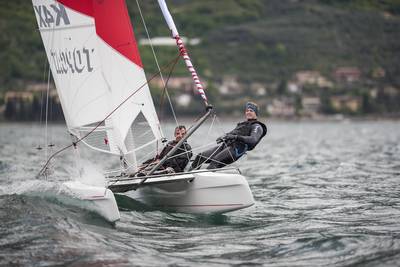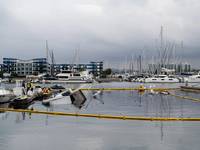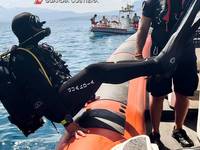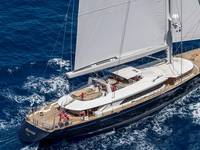TOPCAT Launches Modern Catamaran Fun for Beginners
TOPCAT is the epitome of multihull sailing fun in Germany. For almost 40 years, sports and beach catamarans made of polyester have been highly regarded around the world by recreational skippers and racing fanatics alike. With the K4X model the company, which is headquartered in Inning am Ammersee close to Munich, has brought a 15-foot boat to market in 2017 that has been optimized using computer simulations. The innovative hull shape of this all-rounder offers greater buoyancy – thanks to its U-frame hull (instead of a V-frame) – and therefore greater safety, while simultaneously achieving faster speeds. All this is available at a sailaway price starting from € 8,900 ($10,000).
The new TOPCAT K4X remains true to the successful concept from the major German catamaran builders and rounds off the K1, K2 and K3 range at entry level. Its simple handling, also in terms of deck hardware and trimmers, together with solid construction at affordable prices, are the primary features of this boat. The daggerboard-less hulls with a single fin to counter drift have always been manufactured exclusively for TOPCAT in the Italian town of Cesena. The lightweight construction using glass-fibre reinforced plastic (GFRP) also satisfies the highest demands in terms of robustness. The tool-free mounting of the push-in connectors for the crossbeams, masts, sails and accessories are sourced from across Europe – but the majority of these are made in Germany. The X in the K4 name does not stand for ‘face lift’, but for ‘body lift’ – because the hull shape has been completely remodelled.
The prows of the TOPCAT K4X no longer project forward at deck height in the classic fashion, but extend lower down at the water’s surface. The negatively angled stem, with the widest part of the hull located at water level, is called a wave-piercer as it pierces through the water instead of riding over the crest tops. This “next generation” boat sails more smoothly than its K4 predecessor. The X now hardly undercuts the waves because the hull volume – discounting the boat’s overall increase in size – is larger in its lower areas as a result of the U-frame. The risk of digging in – and therefore capsizing – is further minimized, particularly when sailing downwind, by so-called chines. These are widenings in the forward upper areas of the hulls, which provide a safety reserve should the hulls happen to submerge as a result of a sailing error.
The U-frame hull is associated with improved performance, because the wetted hull surface is reduced but the crew weight remains the same, thereby increasing the speed potential by some eight percent in comparison with the predecessor model. The development of this hull design using flow simulation on a computer – a process borrowed from the aerospace industry – has been rewarded by the Bavarian Ministry of Economic Affairs and Media, Energy and Technology with an innovation voucher. Furthermore, the resulting original mould (positive core) was milled completely using CNC technology to produce the half-shell moulds and this has optimised the precise-fitting quality for subsequent series production.
Another objective was to achieve an increase in buoyancy in order to ensure the catamaran is still comfortable for a three-man crew while adopting a safe design approach. The volume of the hulls has increased by 25 percent overall. This allows sailing schools and clubs to place an instructor aboard. Furthermore, small family groups at resort hotels, in particular, can now set sail together. “The K4X is an absolute all-rounder”, comments TOPCAT boss Pablo Walden, “Two eleven-year-olds are able to manage the cat just as easily as active adults, and even parents with two children have space for fun aboard.”
The K4X meets the needs of various target groups with its four different basic configurations which are primarily characterised by their sail rigs. The Solo is aimed at price-conscious single-handed sailors and has just a single mainsail (11 m²). In its basic version it costs only € 8,900 gross ($10,000). The Classic variant adds a two-square-meter foresail in the form of a roller furler (€ 9,500) ($10,700). This equipment level is usually used by sailing schools and holiday resorts. Ambitious sporting sailors go for the Streamcut (€ 10,500) ($11,800) with a 13.1 square-meter square top mainsail. Last but not least is a gennaker, now in widespread use in the leisure sailing sector, which comes in the form of a ten-square-meter roller-furling gennaker on the K4X model. This delivers added downwind sailing fun for a total of € 12,100 ($13,600). The roller-furling gennaker, newly designed by TOPCAT, is particularly beginner-friendly and safe, because it can be rolled in and out in a matter of seconds.
A further key aspect of this all-round cat is the option of transporting it on a car roof-rack instead of a trailer. For this purpose, TOPCAT offers a split mast, the longest section of which is, at 4.70 meters, nearly the same length as the hulls. The price supplement amounts to just € 550 ($619). This offers the additional advantage of making winter storage in a garage easier. Further extras available upon request include Anticoralli hull reinforcement for sailing schools, keel shoes for sailing waters with stony shores, two different boat trolleys, high-quality Pentax sails, a ball-bearing traveller system and a second trapeze for the helmsman.
Specifications
Length: 4.50 m (15 feet)
Beam: 2.21 m
Mast height: 7.0m (split into 4.70 and 2.70 m lengths)
Mainsail: 11 m² (Classic)/13.1 m² (Streamcut)
Roller furling jib: 2.0 m²
Roller furling gennaker 10 m²
Overall weight: Approx. 115 kg (depending upon equipment)
Transport: Can be carried on a car roof-rack
Number of crew: 1 to 3
Crew weight: 60-225 kg





